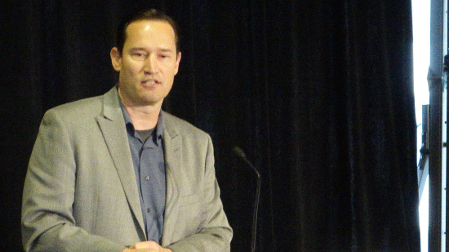SMPTE 2015: Linear Lives
HOLLYWOOD—Once in a while, you just want to turn on the TV and watch. No searching. No scrolling through a program guide. Just good old-fashioned couch potatodom.
“Sometimes, you just want to sit down and tune in and turn off,” said Ted Middleton, chief product officer at Verizon Digital Media Services in Los Angeles. “Sometimes, I just want sit down and turn the clicker on and watch. Now I have to think about it. What application is that on? And where is that app… ? We’ve created an environment where people have to think about what they do before they watch. That’s the [video-on-demand] space.”

Ted Middleton
Middleton delivered the keynote at the Industry Luncheon on the opening day of the annual Technical Conference of the Society of Motion Picture and Television Engineers, a group that will mark its 100th anniversary next year.
Middleton’s keynote followed some organizational housekeeping that included recognition of Wendy Aylesworth, the first woman to serve as SMPTE’s president, and a trailer for “Moving Images,” a documentary in the works commemorating SMPTE’s history. So far, $80,000 has been raised to make “Moving Images,” a retrospective of the science of cinema and television. (Note: The article previously said $1.6 million was raised for the film, but SMPTE now says the $1.6 million was raised for the Next Century Fund, which cannot be used toward the film. $80,000 has been raised for the documentary, and the organization continues to seek donations.)
Middleton meditated on the distribution side of that trajectory. He spoke about how much the technology in linear TV had changed a great deal in the last five decades, but that the user experience is pretty much the same. And it’s pretty much the same in large part because there are just times folks want to veg out.
Consequently, reports of the impending doom of linear TV are premature, he said, despite perceptions to the contrary. That it provides no predominant mobile experience. It’s anchored to a schedule. There are too many channels. Linear TV subscription services are on the decline.
“In TV today, there’s a vast amount of content to choose from, but consumers are asking, ‘Why am I paying for all of this when I only use a little bit of it?’ The actual number of channels being tuned into hasn’t changed, despite the multitude of channels available.”
VOD, on the other hand, is available everywhere; it’s less expensive, has few or no commercials and it is, as the name implies, available on demand.
Linear TV has its advantages, however. It can be live, local and viewers can be “dumped into the action. You don’t have to do a lot of thinking.” And there’s a “rewatchability” factor in terms of playing content again and again.
“The end of broadcasting? I don’t think that’s coming, but it’s going to change. In the next 10 years, many people won’t be paying for TV,” he said, adding that he doesn’t like the term “cord-cutting.” People are using said “cord” to bring broadband into the house.
Middleton described how Verizon Digital Media Services was created to bring together a digital platform to allow broadcasters and publishers to take their linear content and put it into a digital delivery platform with a unified workflow for VOD, live and linear.
“You’re creating assets in the cloud that you can stitch together any way you want,” he said, including custom lineups and targeted ads for individual users, and perhaps a premium subscription service with no ads.
Middleton said the platform takes one mezzanine signal feed and modifies it for display on various device profiles, with ads being adjusted to match the aspect ratios, bit and playout profiles of the content. Refinements in search, discovery and recommendation will be necessary going forward, he said.
“We’re going to start to see, as more of these players come on line, it will be more complicated,” he said. “‘Can I search across content libraries that different providers have aggregated?’”
On the technology front, Middleton said LTE multicast will allow publishers to create broadcast-like experiences in a venue or a region that has the bandwidth to do multicasting.
“It might be a racing event, a sporting event, a theme park… We did a big test with IndyCar,” he said. “Consider creating an app that users download. You can broadcast to a large pool of viewers very efficiently.”
Looking forward, Middleton said the cloud DVR was a solution looking for the appropriate technical approach without triggering litigation. Also, he said, ads have to become more targeted, more engaging and less intrusive; bundling and packaging has to evolve.
Get the TV Tech Newsletter
The professional video industry's #1 source for news, trends and product and tech information. Sign up below.
